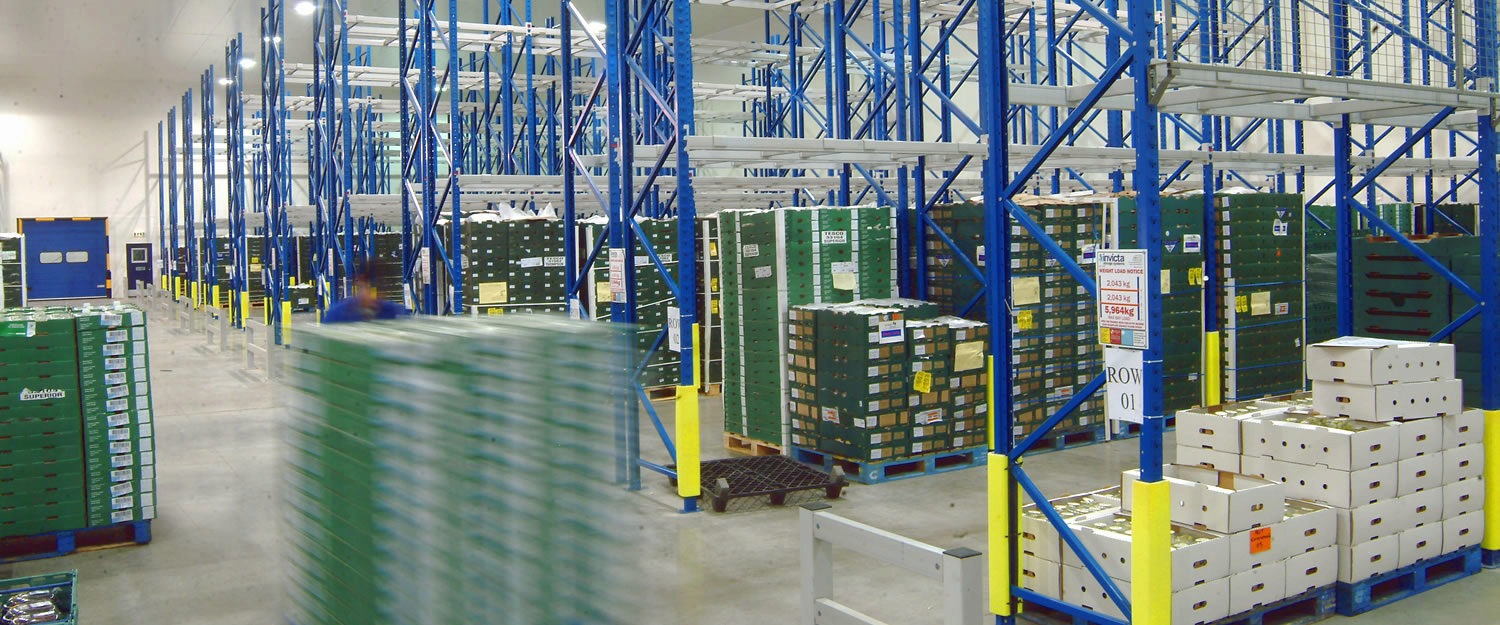For your information
You are being redirected to one of our divisional subsites which contains more detailed information on the required division. To navigate back to the main Invicta Group site, please click the link found in the footer at the bottom of the page.
Manual vs automated racking: picking the right one for your warehouse
15th January 2025
Quick Quote
Contact Mick Coyne
To get a quotation or arrange a free site survey - Call Mick Coyne on
-
 UK
UK
Current location:
Quick Quote
Contact Mick Coyne
-
 UK
UK
Current location:
The exponential growth in ecommerce has created new demand for warehouse space, and for finding efficiencies within existing warehouses. But it’s also changed methods of fulfilment for many businesses. Smaller fulfilment centres are being deployed in urban areas to ship commonly ordered goods, while different racking formats are being utilised to suit different access requirements, supporting both manual and robot-assisted picking.
If you’re looking to outfit a new warehouse or upgrade an existing one, the racking formats you choose can have a huge impact on your throughput and effective storage space. One of the most pertinent questions today is whether it’s worth investing in automated racking solutions, and embracing the oncoming era of warehouse automation. Here are a few pros and cons for each – and the potential benefits of combining both options.
The benefits of manual racking
Manual racking systems are the bread and butter of most warehouses. Despite this broad classification, however, there’s an enormous amount of variety available in manual pallet racking. Different systems can cater to different items and pallet sizes, and facilitate different picking methods and workflows.
Cost-effectiveness
For those who can resist the allure of automation, the biggest benefit of manual racking systems is cost. The simplicity and availability of pallet racking means that even more niche formats tend to require a much lower initial investment than an automated solution, which not only needs specialised racking but also autonomous vehicles.
The money saved from investing in manual racking can be deployed elsewhere, whether that’s to expand or upgrade your racking, reconfigure your space to improve fulfilment workflows (e.g. by bringing racking for popular items closer to a packing area), or even invest in automation elsewhere in the warehouse. This makes them not only ideal for businesses starting out or with a limited budget, but also those who wish to retain the flexibility to adapt and expand over time – potentially adopting automated racking later on.
Flexibility
Where automated racking systems can be extremely specialised, manual racking offers a wide range of configurations. From double-deep to multi-tier to live racking systems, manual racking can be adapted to maximise the storage capacity of any given space. When it comes to our racking systems, they are also modular, allowing for systems to be expanded, reduced in size or augmented over time to support new use cases.
Manual racking can also be partly mechanised or automated with the addition of specialised options, such as pallet shuttle racking or live storage racking. These cover every level of density and picking requirement, allowing for fast retrieval of commonly-ordered SKUs and efficient storage of less commonly-ordered items.
Ease of use
The familiarity of manual racking comes with a few separate benefits. For one, it’s easier to operate on a day-to-day basis, with less in the way of training requirements, and less to worry about in terms of safety around autonomous vehicles. Warehouse operatives can quickly get up to speed with a variety of manual racking types, maintaining high productivity.
The other aspect of this is that it’s often easier to maintain and repair. Because automated racking is more niche and has fewer providers, it can also be more difficult and expensive to fix if there is any damage or any issues with the automation. Most manual racking formats are modular and widely used, meaning they can be easily repaired, removed, relocated or extended.
However, manual racking also comes with drawbacks:
Space utilisation
There are many formats of manual racking which offer high-density storage, ranging from narrow-aisle to double-deep racking. However, automated racking can benefit from the reduction or removal of aisles to create the highest density, multi-tier racking.
The ability to send vehicles up and along racks – or in the case of the advanced racking used by Ocado, to move goods up through a vertical stack – means that automated racking offers exceptional density in certain circumstances.
Labour costs
Perhaps the fundamental drive behind the growth of automation is the desire to reduce labour costs. Storing, removing and picking from pallets takes time and can be physically strenuous, especially for higher shelf locations.
This can not only lead to increased labour costs as your pick volume grows, but also result in downtime due to injury and fatigue. These absences then have to be covered – and all of this in a labour market where trained warehouse personnel are increasingly difficult to find.
Safety concerns
Manual racking requires the use of forklifts, often operating in a busy warehouse. The result is that collisions can very easily occur, either with racking or with personnel. This poses an obvious safety risk, and is a major focus in warehouse safety training.
With manual racking, this safety risk always exists and has to be mitigated through training, signage, floor markings and other methods. While there are still safety risks with automation, these are gradually being lessened by advanced sensor arrays on the vehicles, which tend not to pose the same serious risk to life and property that a forklift collision can.
The benefits of automated racking systems
Automated racking systems, like stacker cranes and carousel systems, can offer advantages for high-volume warehouses with a limited number of SKUs. The limitations of the technology are gradually being overcome, and its usefulness is expanding to more business cases, more items, and lower budgets.
Increased speed
Items in a warehouse with manual shelving move as fast as human operatives can. While there are various methods to more quickly find and pick items, there will always be an element of lag in human response times, as they figure out where the item is and then commute to it, travelling around the warehouse.
Automated systems can integrate with a warehouse management system to automatically receive and execute picking requests, either fetching them directly from the rack in an AS/RS configuration, or sending an autonomous vehicle to the pick face. This integrated approach can significantly reduce picking times and help to fulfil orders more quickly.
Space optimisation
In cases where only small items need to be stored and retrieved, it is possible to build a large automated racking system whereby items are retrieved using a small vehicle attached to the racking. This can navigate the pick face by moving up and along the racks, locating items and bringing them to a packing station.
The ability to remove the need for forklifts means that the racking can almost eliminate the need for aisles, and use more headroom than might otherwise be possible with a manual system. This efficient use of vertical space can allow you to store more inventory in a smaller footprint, assuming that all of your SKUs can be retrieved in this way.
Accuracy
Another area in which automated racking can improve productivity is the reduction of human error. Manual picking can result in the wrong items being retrieved, or being retrieved in the wrong way, causing unnecessary damage. This can cause unnecessary loss of inventory and time, something that can snowball as bottlenecks form in the warehouse.
Automatic retrieval minimises human error by ensuring that any problem is with the system controlling the automation, rather than the fallibility of the automation itself. This should ensure that the right item is picked every time, and that any mistakes can be permanently corrected, leading to higher picking accuracy and improved inventory control.
However, there are also downsides to consider:
The drawbacks of automated racking systems
High initial investment
The most obvious and transparent issue with automated racking is cost. Automated systems generally require a significant upfront cost, often including hardware, software, and installation, as well as secondary costs such as employee training.
While robotics-as-a-service (RaaS) companies increasingly lease autonomous vehicles, these may not be compatible with all racking systems, locking you into whatever racking and robots they support.
Less flexibility
Due to the need to accommodate the autonomous vehicles that interact with the racking, automated systems are typically less adaptable to changing needs compared to manual systems. Modifying an automated system can be expensive and complex, and may not even be possible, depending on what it is you wish to achieve.
The most obvious example would be if you need to store items the autonomous vehicles or robots cannot handle, either due to their weight, size or shape. Items which fit on cantilever racking are unlikely to be supported by these vehicles, so you may end up having to reduce the size of your system to accommodate both manual and automated racking systems, which could be expensive and disruptive.
Maintenance requirements
Where most pallet racking is renowned for being hard-wearing, automated systems naturally require more maintenance. This not only means regular maintenance for the vehicles or robots, but also for the tracks or other systems they use to navigate the warehouse and racking.
automated racking also tends to have higher ongoing operational costs due to the energy requirements involved. There may also be other costs related to the use of automated racking, such as a need to improve fire protection measures to account for the increased density of racking and increased amount of vehicles and electronics.
Choosing a system
The ideal racking system will always depend on the unique circumstances of your business. The first key consideration should be what you currently store, and what your intentions are over the next five to 10 years. A warehouse with a large variety and quick rotation of SKUs will generally benefit more from the flexibility of manual racking.
Next you may wish to consider your warehouse size and layout. A small floorspace with substantial headroom may make automated racking the most space-efficient solution. If the space is awkwardly proportioned, then one or more manual racking systems might be adapted to fill different areas, such as using a narrow aisle format in a more constrained part of the space.
Budget is also a key consideration. Automated systems can offer significant long-term value, and RaaS operators have reduced the onboarding, maintenance and upgrade costs for automation to a point that they are more viable for smaller operators. However, the racking itself still generally requires a significant initial investment.
Staff resources are also relevant. Both types of systems require different skills to operate, and the benefits of reducing labour costs must be weighed against the difficulty and cost of hiring specialists in automation. This means not just operating the systems (some of which can be trained), but also performing regular maintenance and oversight, which are more specialised.
–
At Invicta Racking, we have extensive experience designing and installing both manual and automated racking systems. We’ll work with you to understand your specific needs, and recommend the optimal solution to maximise your warehouse efficiency and profitability. To discuss your project and arrange a complementary site visit, get in touch with us today.










Share/Like this page